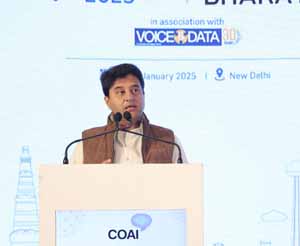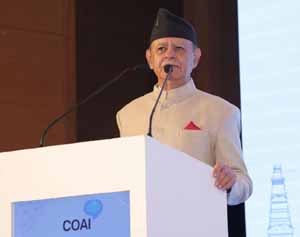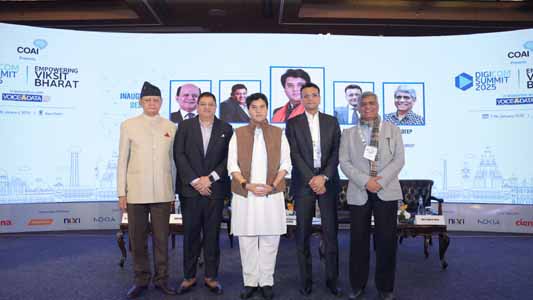The Cellular Operators Association of India (COAI), the official voice for the Indian telecom industry, organised the first ever DIGICOM Summit 2025 today. The event was graced by Shri Jyotiraditya M. Scindia, Hon’ble Union Minister for Communications, Shri Anil Kumar Lahoti, TRAI Chairman and other industry leaders. All stakeholders came together for this unique full day conference spanning across 5 sessions with several participants to discuss how digital infrastructure is bridging the digital divide and driving equitable growth, ensuring that technological progress reaches and uplifts every section of society, under the theme of “Empowering Viksit Bharat”.
Digital India is at the forefront of transforming the nation into a leading global economy by enhancing connectivity, improving public services and driving sustainable economic growth. In-line with the values of the initiative, the one-day event witnessed keynotes and session discussions by industry leaders across topics like telecom and digital infrastructure, policy & regulations, 5G ecosystem, emerging technologies, Make in India initiative, impact on livelihood, role of academia, digital connectivity, citizen empowerment, internet of things, edge computing, interconnected machines and innovations fostering inclusivity and enabling sustainability.

In his inaugural address, Chief Guest Shri Jyotiraditya M. Scindia, Hon’ble Union Minister for Communications said, “Telecom is contributing to about 7% of India’s GDP and growing at a decadal CAGR of between 14%-16%. Our policy frameworks have been completely revolutionized, making them the bedrock and the foundation of this digital revolution, and our ease of doing business capability has brought innovation across multiple spectrums. Our digital connectivity is uplifting livelihoods. If you look at how India has transformed under the leadership of PM Narendra Modi, it is this telecom sector today that is powering a giant trinity. 531 million people that were out of the banking networks, today have electronic bank accounts and telecom is also the backbone of our thriving startup system. We have followed the world in 4G, we are marching with the world in 5G, and our efforts are there for India to lead the world in 6G. We are committed to contributing 10% of the 6G patents to the world. Telecom is the industry which has a value-additive approach and adds value to each sector. We have an approach to take feedback from the industry and craft policies accordingly like we have seen in the case of RoW. It is also my hope and dream that India by 2030 transforms itself into a telecom product nation and we build our telecom manufacturing zones and entire ecosystem.”
In his keynote address, Shri Anil Kumar Lahoti, Chairman, TRAI said, “Today 97% of the villages in the country have 4G connectivity and over 99% of the districts have 5G connectivity. BharatNet has now connected over 2.14 lakh gram panchayats through optic fiber networks and over 5000 gram panchayats through satellite links. On the access side, about 1.1 million FTTH connections and over 100,000 public Wi-Fi hotspots have also been added so far. The government has committed to an outlay of $16.6 billion for its implementation for Bharat Net. Apart from connectivity, attempts are underway to augment the delivery of digital services under the Common Service Centres program and to inculcate entrepreneurship at the village level. India generates 20% of the global data but has only 3% of the data center capacity. India plays a key role in global submarine cable network and hosts around 17 international subsea cables across 17 district landing stations. Attaining synergy between the digital and brick-and-mortar economy is vital to realize the goal of Viksit Bharat. India’s diverse skill capabilities coupled with digital means and collective endeavors may open new stars of growth for traditional sectors.”
Mr. Abhijit Kishore, Chairperson, COAI said, “At COAI, we work very very closely with the Ministries, with the Government to address challenges, advocate for robust policy frameworks and create an environment which is conducive to growth and innovation. Together we are working towards connectivity that promotes equitable access and support initiatives that bring in new and evolving business in this sector. While 4G and 5G are revolutionizing the connectivity today, we must look at 6G, Internet of Things and these technologies will redefine how we live, work, interact with each other and create a hyper-connected world with unprecedented possibilities. The progress we have made as an industry would not have been possible without the support and foresight of the Government, the industry and the active participation of the academia as well as the civil society.”
Mr. Rahul Vatts, Vice-Chairperson, COAI said, “The telecom industry has emerged as a key and critical enabler for the economic and socio-economic transformation. Telecom is really powering the digital economy of the country. The industry has made significant investments of more than 2.5 lakh crores just in rolling out the networks, so the industry will focus on future 5G rollouts as also for fiberisation in the country. One of the imperative of the industry is to collaborate – including OTTs which should also share the responsibilities as we try to secure our digital future. Trust and safety remains one of the key pillars for the telecom industry and collaborative efforts are very significantly required to reduce the incidences of fraud and spam.”

Lt. Gen. Dr. S.P. Kochhar, DG, COAI in his welcome address said, “Telecom has become a horizontal rather than a vertical, and in that manner, it is an essential service for empowering the other manifold services and industries. We realize that the most important components in today’s environment are networks, secondly, the data to flow on the networks, third, being the compute power which should be available as and when it is required, and in the capacity that it is required, and the fourth is security. All this is the envelope of policies and regulations which should be aligned to the situation, and which should cater for the changing environment in a giant fashion.”
Witnessing the participation of more than 200 technology decision makers and industry leaders, DIGICOM Summit 2025 served as a platform for the exchange of expertise, market insights, and best practices, for continuous improvement across industries and sectors. The event focused on identified challenges, analysing their root cause and developing effective solutions to overcome obstacles and transforming creative ideas into impactful solutions, driving progress, improving efficiencies and creating new opportunities.












